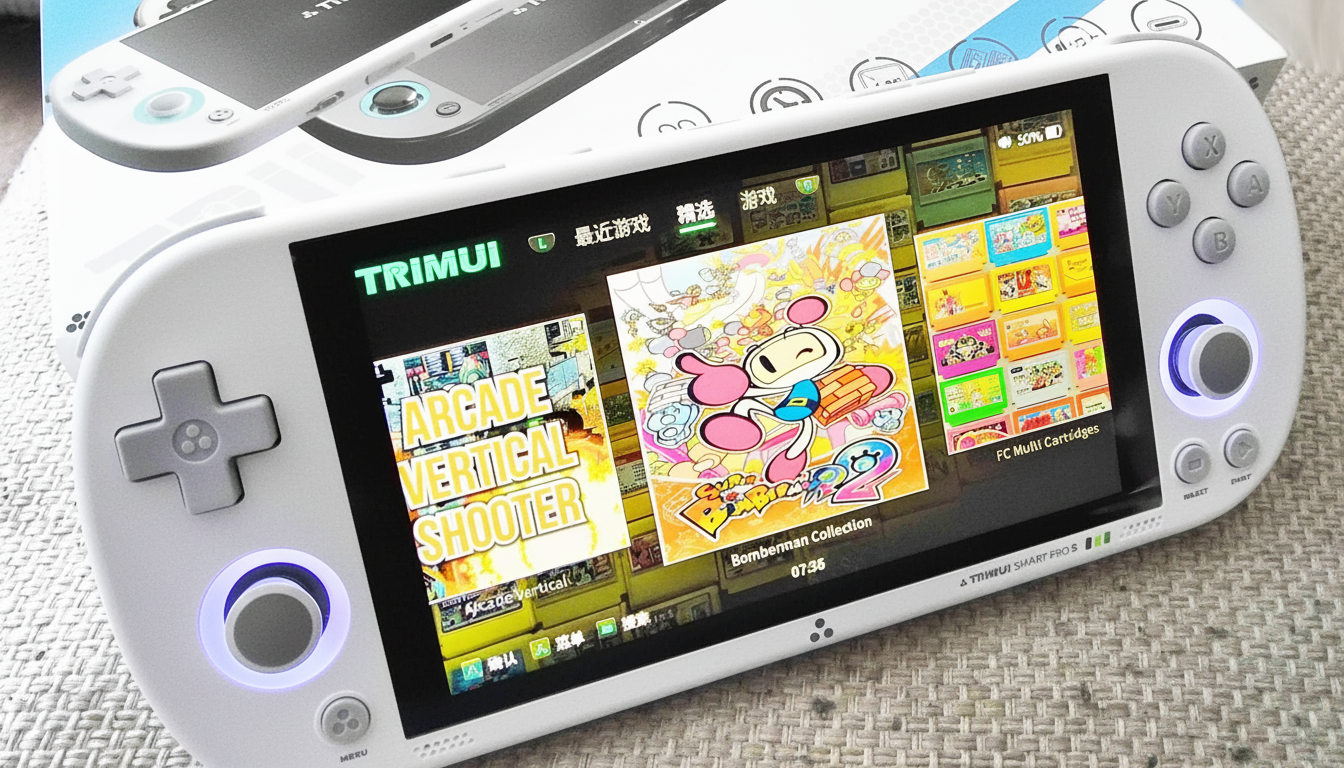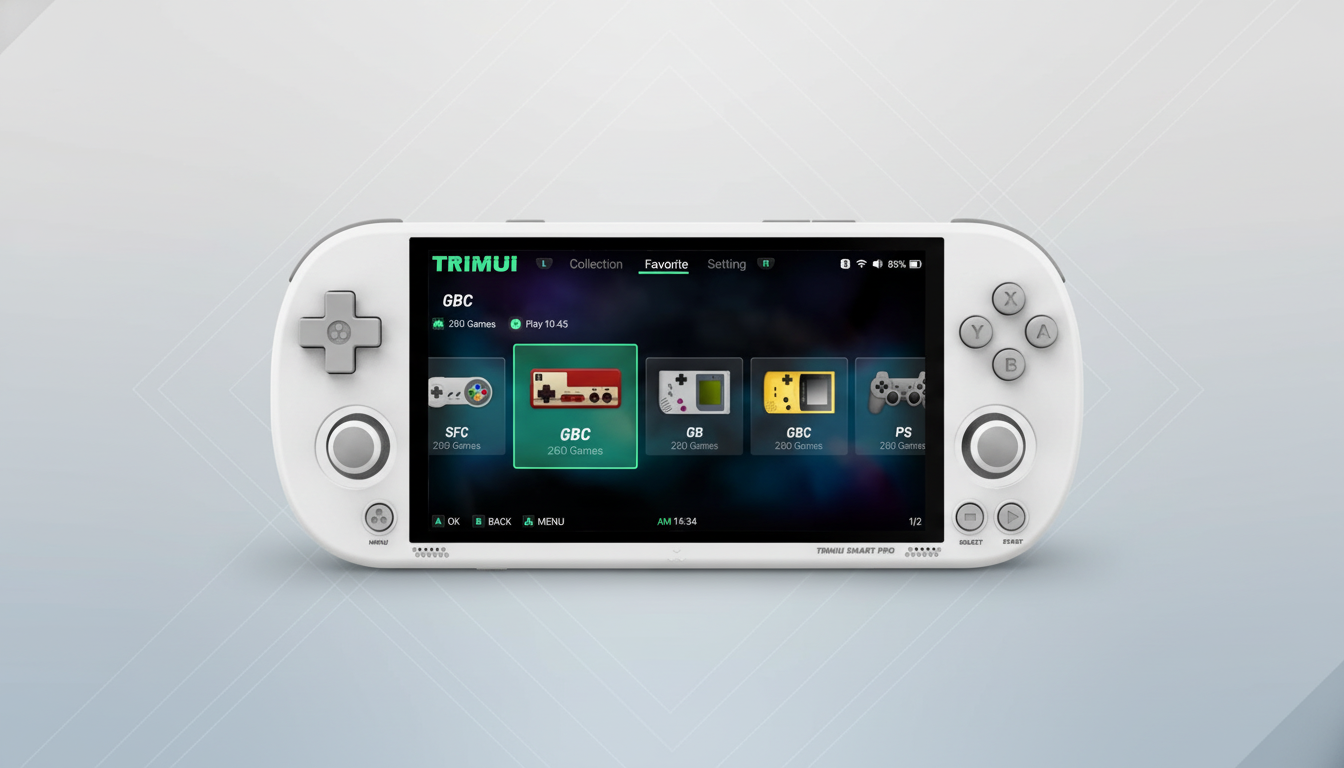TrimUI appears set to update its budget retro handheld flagship with a Smart Pro S that improves core performance, cooling, and platform compatibility based on retailer listings. The product page from handheld marketplace MechDIY has also been leaked and shared by enthusiast site Retro Dodo, with details on the power of the built-in cooling fan, the measured heat dissipation, and which software is better supported. Neither the manufacturer nor TrimUI has formally published this yet. Early retail guidance indicates that preorders might be accessible in the next few weeks, and MechDIY expects to be among the first to stock. However, this reticence toward a formal statement, accompanied by just “yep…that sounds about correct” from retailers when these characteristics are read out to them, makes it one to keep an eye on for anyone who favors a pocket-sized emulation solution.
The enormous flag implies that this model is getting a built-in fan, that the SoC is significantly more potent, or that it aims to maintain peak rates under pressure. The previous Smart Pro did a nice job with the PlayStation and Nintendo 64, but an “S” model is capable of more than the Dreamcast and PSP. It may be capable of a lot more, possibly even the GameCube or Wii on certain titles, depending on the ultimate silicon and maturity of the optimum software.

Ergonomic and heat-dissipating design tweaks amount to much as well. Thermally aware shell geometry, revised venting, and higher-conductivity internal materials can help slash hotspots and keep things comfortable in longer sessions, typically overlooked but ideal for handhelds where palms and triggers come into constant contact with toasty surfaces.
MechDIY’s preview claims the Smart Pro S is “optimized for both Android-based apps and a wide range of classic emulators.” That may hint at an Android build, something of a shift, as the current Smart Pro sports Linux-based firmware. Android could win users wider app availability, modern emulator front ends, and seamless updates, while maintaining access to RetroArch, Dolphin, PPSSPP, and one-off cores. On the other hand, Linux has paramount importance to the retro scene: killer boot times, lightweight overhead, and smooth launcher integration. Many Linux handhelds ace the out-of-box user experience with effortlessly integrated front ends on first boot. The platform choice will determine your driver support, input latency, battery life, suspend behavior, and how fast the community can optimize builds for the newest units. MechDIY’s trailing track record on firmware updates and strong community engagement will be equal factors to what the spec sheets reveal.
Why cooling and design choices matter for this handheld
Active cooling can bridge the gap between short performance spikes and longer, smoother play. That will likely matter most in high-profile cases: like running an emulator on Steam Deck or a cooling-equipped Switch, where the fan can keep clocks up high in long sessions and users will notice reduced stutter and throttling. In 3D, this could manifest as steadier frame pacing and less frame rate reduction in demanding titles, especially those being upscaled or enhanced with texture filters.

Fans do come with trade-offs. These moving parts actively consume power and can become noisy. The Smart Pro S’s success will largely hinge on TrimUI’s acoustic tuning, smart fan curves, and a battery large enough to offset the extra thermal headroom. However, if the company pairs that fan with an efficient chip and carefully sculpted thermals, the trade-off will probably be an overall win for most users.
TrimUI has an established market reputation for value hardware: where “value” is usually code for “significantly smaller and cheaper than mid-range Android handhelds.” The Smart Pro S appears poised to fill the space between under-$100 emulation toys with passive cooling and console-class portables worth several hundred dollars. The device competes with most pick-up-and-play action on 5-inch-ish screens, rather than a segue into AAA streaming or high-end 3D. The overall handheld market is chugging along steadily. There is an ongoing need for devices that balance portability, affordability, and usability. In this space, subtle things like UI responsiveness, buttons that have a good, clean feel, and the ability to suspend and resume reliably can be almost as important as headline specs. If TrimUI hits enough of those right notes and throws in a verifiable performance uplift, the S could become a perennial recommendation.
Key specs remain unknown until the official reveal
The key details still missing include the SoC, RAM and storage configurations, display resolution and brightness, battery capacity, and the operating system. Also watch for official claims around emulator targets and any bundled front end.
- System-on-chip (SoC)
- RAM and storage configurations
- Display resolution and brightness
- Battery capacity
- Operating system
- Official claims around emulator targets and any bundled front end
Retailers suggest preorders are approaching, MechDIY says it expects early official stock, but final pricing and firmware support windows will ultimately decide how compelling this upgrade offering is. Bottom line – if you liked the Smart Pro for its size and simplicity, the Smart Pro S seems poised to deliver more power and better thermals without ever crossing TrimUI’s compact ethos. The OS decision – Android or Linux – may define the outing as much as the fresh processor, so the official revelation seems all the more significant for the retro handheld crowd.

